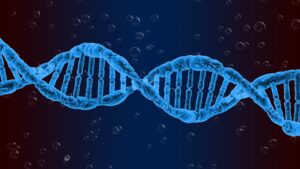Exons are the part or portion of the gene which codes for amino acids. Prokaryotes have a very simple cellular organization. So, Do Prokaryotes Have Exons?
Do Prokaryotes Have Exons, Yes. Prokaryotes have only exons in them. We know that prokaryotes are unicellular organisms and have a simple cellular organization. So, they lack complex mechanisms like post transcriptional modification etc. Thus they possess only exons in them.
Read more on DNA Structure
Why do prokaryotes only have exons ?
In eukaryotes, once the mRNA is transcribed from DNA the introns in the mRNA will be cut and the exons will be combined together.
But, Prokaryotes are simple and have simple mechanisms evolving in their structure. So the introns are absent in them, they only have exons in their genes.

Image credits: Pixabay
Where are exons located in prokaryotes?
The exons are present in the gene of the DNA of the organism.
Do eukaryotes have exons in them?
Eukaryotes are complex organisms and undergo complex mechanisms for survival.
Yes, Eukaryotes have exons in them.
They also have introns which are cut off and the introns are connected together using a protein complex called spliceosome.
Do eukaryotes have more of introns or exons?
Eukaryotes have both in them ( introns and exons).
Approximately, it is said that there are about 7.8 introns and 8.8 exons in a gene.
It depends on 1 organism to another based on their morphology complexity.
Why prokaryotes don’t have both introns and exons in their genes?
Prokaryotes have a straightforward mechanism in them.
Prokaryotes do not have enough space in them as well as in prokaryotes, post transcription the translation process immediately initiates or in some cases it happens simultaneously. Thus there is no time for intron splicing.
There is no mechanism of post transcriptional modification. So they do not require introns in them.
Read more on Bacterial DNA replication steps.
Simplified version of prokaryotic transcription:
Transcription is a process in which a portion of the DNA is copied into a mRNA strand which is newly synthesized with the help of RNA polymerase enzymes.
The prokaryotic transcription is performed in three steps.
Transcriptional Initiation:
The process initiates, in which the enzyme RNA polymerase recognizes the promoter region of the gene and unwinds the DNA.
Transcriptional Elongation:
The new free nucleotides attach to the DNA strand and due to which the attachments elongate and the mRNA strand is being formed.
Transcriptional Termination:
Once the enough strand is made, the enzyme and other cofactors that is associated in DNA complex, dissociates itself from the DNA and the process is terminated
As the end product, newly synthesized mature mRNA is produced which is ready for translation.
What will happen to the mRNA post transcription?
In prokaryotes, the transcription process takes place in the cytoplasm.
After the mRNA is synthesized, a process called translation that is the protein synthesis takes place.
In prokaryotes, the process of transcription and the process of translation process are combined or coupled. The transcription completes and immediately the translation starts or in some cases the transcription and translation process happens simultaneously, which is called a coupled process.
Simplified version of prokaryotic translation:
Translation is a process in which the transcribed mRNA strand codes for amino acid and the synthesis of protein takes place.
The translation process in prokaryotes takes place in the cytosol organelle of the cell. The subunits such as large and small of the ribosome attach to the mRNA for translation that is synthesis of proteins process.
Prokaryotic translation also consists of 3 stages.
Translational Initiation:
Assembly of the ribosomes ( large and small subunits) around the mRNA takes place. The first codon (start codon) is attached or binds to the initiator tRNA.
Translational Elongation:
The same process of attachment of the codon is being done and all the peptides are combined to form polypeptides.
Translational Termination:
Finally the stop codon comes in and the process is terminated.
Also Read:
- Soil bacteria examples
- Codon vs anticodon
- Do chloroplasts have dna
- Light dependent reaction example
- Hydrolase enzyme examples
- Do animal cells have a central vacuole
- Is the cell wall rigid
- Tundra biome examples
- When does the cytoplasm divide
- Staphylococcus bacteria examples

Hello, I am Sugaprabha Prasath, a Postgraduate in the field of Microbiology. I am an active member of the Indian association of applied microbiology (IAAM). I have research experience in preclinical (Zebrafish), bacterial enzymology, and nanotechnology. I have published 2 research articles in an International journal and a few more are yet to be published, 2 sequences were submitted to NCBI-GENBANK. I am good at clearly explaining the concepts in biology at both basic and advanced levels. My area of specialization is biotechnology, microbiology, enzymology, molecular biology, and pharmacovigilance. Apart from academics, I love gardening and being with plants and animals.
My LinkedIn profile-